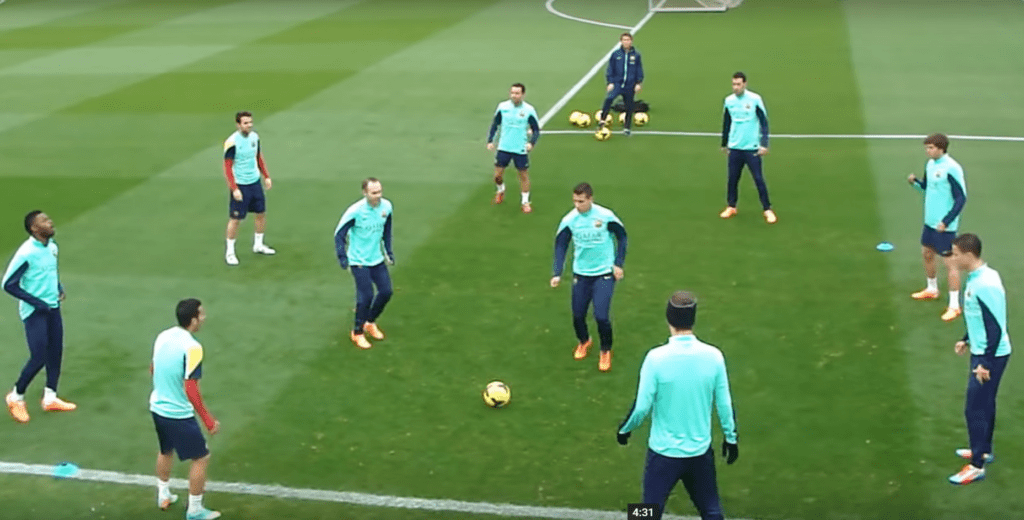Rondos are important to the training systems of some of the world’s top academies like Bayern Munich, Manchester City, and Barcelona. The success of Rondos for creating good team play has become increasingly popular for youth coaches to implement, partly due to their simplicity.
One of the main objectives for using rondos is the development of young players’ tactical and positional awareness – but the technical side is also a huge benefit of using them.
“What I learnt here is everything starts with the ball and ends with the ball. Sometimes we forget that it’s a game of 11 v 11 with ONE BALL. We try to keep this ball, we try to play with this ball, we try to make everything with the ball. This is what we learn when we start as children there.”
Pep Guardiola
Check below some of the best Rondos from FC Barcelona Youth Teams.

Upgrade your coaching skills with FootballCoach365 Premium! Get expert insights, video tutorials, tactical playbooks, training sessions, and more. Elevate your game – subscribe today.
Elevate Your Coaching Game with FootballCoach365 Premium Subscription!
- 30-Minute Online Session with Our Expert Coach
- “Ask Me Anything” Option
- Premium Exclusive Content
- Complimentary Copy of “How to Train Positional Play” for Free
Here are the 9 most important benefits of using Rondos:
1. Cognitive
Players have to constantly make decisions based on their teammate’s and opponents’ positions and where the ball is located. Any mistake results in the loss of the ball. The player who loses the ball is going into the center so it encourages players to take the correct decisions quickly. The pressure of the rondo forces players to use different techniques and strategies. They learn when to use 1 or 2 touches based on the situation. Players are constantly challenged and have to cope under pressure.
The positions of teammates, opponents, and ball speed are all changing which gives motivation to the players. This helps to keep players focused and engaged throughout the session and develop their mental awareness.
2. Develop Technical skills
Technical ability, in brief, is the ability to handle the ball (including control, dribbling, passing, receiving etc.). Skill is the ability to use a technique with high quality under the pressure of time and in tight spaces. Due to the way that the rondo is set up, it is necessary to have control of the physical movements and technical skills with respect to time and space, the game, the ball and opponents. Great footwork is essential to playing a fast-paced, possession based style of football. Rondos are key factors to achieve it.
Rondos are Guardiola’s preferred method of choice for improving his team’s on the ball skills. The intensive pressure of the defenders in so tight spaces forces players to practice passing and receiving but also circulating the ball quickly.
- Short Passing
Rondos are all about short passing in tight areas of the game. Using rondos gives your players lot of repetitions playing passes at short distances under pressure.
- Improve receiving and 1st touch
The tight spaces force players to have a good first touch to give them the time and space to maintain control of the ball. Playing in tight areas is crucial for high-performing teams who usually will have to face teams playing in a low block, closing all the spaces. The players need to be comfortable being pressed so they don’t panic on matchday.
Rondos are an excellent way to simulate matchday pressure. When a coach uses very often rondos in his training sessions will give his players a hugely competitive and confidence on matchday.

3. Rhythm of play
The control of the game’s rhythm is of high importance in our days. The constant increase of the game’s physical demands forces the teams who want to compete in many competitions during the season to find ways to keep their players fresh. The proper management of a game is essential.
Throughout the game is impossible to keep a high intensity for the whole 90 minutes. Even teams who love to attack and press all the time, like Klopp’s Liverpool, have to maintain a slower tempo at some point of the game.
Rondos can help players understand when to play fast and when to slow things down depending on how close the opposition player is. A light example was Iniesta when was playing at Barcelona. Iniesta was well known for his ability to use “La pausa”. “La pausa” is a Spanish tactical term that means to pause, stop or slow down with the ball to change the rhythm of the game.
The pressure of the drill helps players learn and recognize when to play fast or slow but to do it without time to think. To do it by habit.
The repetition of quick and instinctive passes players in rondos drastically improves each individual’s speed of play. As a result, players can comfortably transition these skills into matchdays and hugely improve the speed they can move the ball.

4. Team Building
The players in a rondo work close together so the teammates create a relationship between them. They better understand each other. The sense of “team” becomes the norm. Rondos are drills usually played in small groups which help the players to come close and cooperate to “solve problems”. If a coach uses regularly such types of drills but changes every time the groups, will give the opportunity to all players to work with all their teammates.
5. Creativity and Expression
The set up of rondos forces the players to use various technical and tactical techniques to solve constantly changing situations within the game. This helps develop creativity. Players must think ways to keep possession of the ball by movements and the ways they receive and pass the ball.
6. Maintain ball possession
Rondos main priority is for the players to keep the ball possession. In simple words, “keep the ball away for the player’s inside”. Another name for rondos is the “Pig in the middle”. It’s their job to get the ball, so you need to work together as a group – a key part of winning soccer matches.
- Always support the on the ball player
Players must understand that they should continue moving after they have passed the ball. They must stay available for the ball to be passed back, or run into space to provide another option. In this way, players always have a passing option.
7. Competitiveness
Competition between players is high. Players have to fight to make space. Also they have to learn how to hold off a tight marking and how to win the ball back. Nobody wants to be the one making the mistake which leads to time in the middle.
8. Physical conditioning
With rondos a team works on agility, balance and coordination by varying the space, time and number of players involved. Physical condition trainers can use rondos to work on the strength and explosiveness. Especially with the players who are the chasers inside. Change players not after ball recovery but after working for a set of time.
Where I can find examples of rondos?
I have read the below amazing books which includes drills that I personally use a lot:
- The Science of Rondo: “Progressions, Variations & Transitions”
- Pep Guardiola – 88 Attacking combinations and positional pattern
Conclusion
Rondos are probably the most important training tool to us in youth players. In a rondo almost all the elements of football (except from shooting) appears. A coach can develop the team’s technical, mental, physical and tactical abilities all t the same time. The drill is always motivating for the players because it includes competition and of course the most “fun engaged” item, the ball. The drill is relative simple and by manipulating the rules many technical and tactical elements can be trained.
Subscribe to our YouTube Channel and get notified for any new drill we upload every week.

